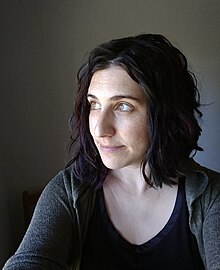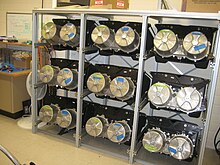Sarah Tuttle
Sarah Tuttle | |
|---|---|
 | |
| Alma mater | University of California, Santa Cruz Columbia University |
| Scientific career | |
| Institutions | University of Washington |
Sarah Tuttle is an astrophysicist and assistant professor of astrophysics at the University of Washington.[1] Tuttle builds spectrographs to detect nearby galaxies, including work on VIRUS[2] (the Visible Integral-field Replicable Unit Spectrograph) installed on McDonald Observatory's Hobby–Eberly Telescope to study dark energy, and FIREBall (Faint Intergalactic medium Redshifted Emission Balloon), the world's first fiber fed ultraviolet spectrograph.[3][4][5]
Early life and education
[edit]Tuttle was born and raised in Santa Cruz,[6] studied physics at the University of California, Santa Cruz and graduated with a B.Sc in 2001.[7] From 2001 to 2002, she worked for Add-Vision in Scotts Valley as a research scientist,[7] and was part of the team that built the first screen-printed polymer light emitting diodes.[8]
Tuttle received a M.Sc and M.Phil in astronomy from Columbia University in 2006 and 2007,[9] and obtained her Ph.D in 2010,[7] working with David Schiminovich on the Faint Intergalactic medium Redshifted Emission Balloon (FIREBall).[3][4][5] Tuttle built the world's first fiber fed ultraviolet spectrograph, which launched on FIREBall in 2009.[5][10]
Research and career
[edit]
Tuttle's research applies novel hardware approaches to spectrograph instrumentation design, particularly aimed to isolate star formation regulation in galaxies through emission and infall from the interstellar medium.[11]
During her Ph.D. at Columbia, Tuttle built the spectrograph for FIREBall, a balloon-borne telescope that is coupled to an ultraviolet spectrograph and designed to discover the intergalactic medium (IGM) in emission.[12][10] The FIREBall spectrograph built by Tuttle was the world's first fiber fed ultraviolet spectrograph and placed upper constraints on IGM emission.[5][10]

Tuttle served as the lead for the Hobby–Eberly Telescope's VIRUS detector from 2010 until 2012, where she prototyped, finalized and characterized the VIRUS spectrograph.[13][14][15][16][17] The instrument consists of 156 spectroscopic channels fed by 34944 fiberoptic channels, covering a 22 arcminute field of view.[18] Tuttle and her colleagues' current astrophysics work still utilizes VIRUS data.[19]
In 2016 she joined the University of Washington as an assistant professor.[11] As of May 2019, Tuttle was leading the recommissioning of the KOSMOS spectrograph for the Apache Point Observatory, an instrument originally stationed at Kitt Peak Observatory.[11][20]
Her science-outreach work includes appearances on the podcast 365 Days of Astronomy in 2009 and writing for The Toast in 2014.[9][4][21] She regularly appears as an astronomy expert in articles in The Seattle Times, The Mercury News and Gizmodo.[22][23][24][25] In 2014, the National Academy of Sciences honored her as a Kavli Fellow.[26][27] Tuttle has also contributed to American Astronomical Society workshops and supported new guidelines to build a more diverse and inclusive environment.[28]
Activism
[edit]Tuttle was a board member and hotline operator for the Lilith Fund until 2016, a reproductive-rights nonprofit that provides Texas women with financial support for obtaining abortions.[29][30][31] She currently serves on the board of Kadima,[32] a Seattle-based Reconstructionist Jewish community.
Her 2015 response to Tim Hunt's statements about women in the laboratory drew international coverage and was featured on BuzzFeed.[33][34] In an interview with Chanda Prescod-Weinstein during the buildup to the 2017 March for Science, The Washington Post cited a group statement by Tuttle, Prescod-Weinstein and Joseph Osmundson on The Establishment.[35][36] Their article entitled "We Are The Scientists Against A Fascist Government" called for greater participation of scientists in politics and compared the political situation in the United States to early-1930s Germany.[36]
She has produced numerous studies on the gender bias within astrophysics, including one published in Nature in 2017 which found women's 1st author papers receive 10% fewer citations than similar papers led by male 1st authors.[37] She furthermore emphasizes the importance of supporting scientists from underrepresented groups.[38]
See also
[edit]References
[edit]- ^ "Tuttle, Sarah". University of Washington.
- ^ Hill, Gary J.; Tuttle, Sarah E.; Vattiat, Brian L.; et al. (9 August 2016). "VIRUS: First deployment of the massively replicated fiber integral field spectrograph for the upgraded Hobby-Eberly Telescope". In Evans, Christopher J; Simard, Luc; Takami, Hideki (eds.). Ground-based and Airborne Instrumentation for Astronomy VI. Vol. 9908. pp. 99081H. Bibcode:2016SPIE.9908E..1HH. doi:10.1117/12.2231064. S2CID 125982527.
{{cite book}}:|journal=ignored (help) - ^ a b "Sarah Tuttle". user.astro.columbia.edu. Archived from the original on 1 July 2018. Retrieved 2 July 2018.
- ^ a b c Tuttle, Sarah (27 July 2009). "July 27th: Astronomical Ballooning – Or, What Goes Up Must Come Down". 365 Days of Astronomy. Columbia University Astronomy Podcast. Archived from the original on 3 July 2018. Retrieved 2 July 2018.
- ^ a b c d Milliard, Bruno; Martin, D. Christopher; Schiminovich, David; Evrard, Jean; Matuszewski, Matt; Rahman, Shahinur; Tuttle, Sarah; et al. (16 July 2010). "FIREBALL: The Faint Intergalactic medium Redshifted Emission Balloon: Overview and first science flight results". In Arnaud, Monique; Murray, Stephen S; Takahashi, Tadayuki (eds.). Space Telescopes and Instrumentation 2010: Ultraviolet to Gamma Ray. Vol. 7732. p. 773205. Bibcode:2010SPIE.7732E..05M. doi:10.1117/12.857850. S2CID 8060117. Archived from the original on 2 July 2018. Retrieved 2 July 2018.
{{cite book}}:|journal=ignored (help) - ^ "Introducing Sarah Tuttle". astrotweeps.wordpress.com. 21 April 2014. Archived from the original on 2 July 2018. Retrieved 2 July 2018.
- ^ a b c "Curriculum Vitae: Sarah Tuttle" (PDF). astrotuttle.files.wordpress.com. Archived (PDF) from the original on 3 May 2019.
- ^ "Screen printable electroluminescent polymer ink" (PDF). World Intellectual Property Organization. 3 July 2003. Retrieved 2 July 2018.
- ^ a b "Sarah Tuttle (CV)". user.astro.columbia.edu. September 2009. Archived from the original on 24 December 2018.
- ^ a b c Tuttle, Sarah E.; Schiminovich, David; Milliard, Bruno; et al. (9 July 2008). "The FIREBall fiber-fed UV spectrograph" (PDF). In McLean, Ian S; Casali, Mark M (eds.). Ground-based and Airborne Instrumentation for Astronomy II. Vol. 7014. pp. 70141T. Bibcode:2008SPIE.7014E..1TT. doi:10.1117/12.789836. S2CID 44516391.
{{cite book}}:|journal=ignored (help) - ^ a b c "Faculty Spotlight: Sarah Tuttle". University of Washington. 6 October 2017. Archived from the original on 3 July 2018. Retrieved 2 July 2018.
- ^ "FIREBALL (Faint Intergalactic-medium Redshifted Emission Balloon) -2007-". stratocat.com.ar. Retrieved 6 May 2019.
- ^ "Update: Mass Production - HETDEX". Archived from the original on 19 September 2020. Retrieved 8 May 2019.
- ^ Garofali, Kirsten (9 June 2017). "Astronomy on Tap Seattle: May 24th at Peddler Brewing". Retrieved 8 May 2019.
- ^ Hill, Gary. "HETDEX & VIRUS: Panoramic Integral Field Spectroscopy with 35K Fibres" (PDF). Retrieved 8 May 2019.
- ^ "MRI: Development of VIRUS2 – A Scalable Integral Field Spectrograph for McDonald Observatory". National Science Foundation. Archived from the original on 2 July 2018. Retrieved 2 July 2018.
- ^ Tuttle, Sarah (2017). "The Era of 'Replicated' Spectroscopy (Colloquium)". Columbia University Department of Astronomy. Archived from the original on 20 June 2018. Retrieved 2 July 2018.
- ^ Tuttle, Sarah (1 August 2016). Evans, Christopher J; Simard, Luc; Takami, Hideki (eds.). "VIRUS early installation and commissioning". Ground-Based and Airborne Instrumentation for Astronomy VI. 9908: 99081I. Bibcode:2016SPIE.9908E..1IT. doi:10.1117/12.2231253. S2CID 124054930.
- ^ Tuttle, Sarah (2012). "HETDEX: Diffuse Lyman-Alpha Emission". American Astronomical Society Meeting Abstracts #219. 219: 424.23. Bibcode:2012AAS...21942423T.
- ^ Tran, Debby; Tuttle, Sarah; McKay, Myles; Kadlec, Kal; Sayres, Conor (2019). "NASA/ADS". American Astronomical Society Meeting Abstracts #233. 233: 146.07. Bibcode:2019AAS...23314607T.
- ^ Tuttle, Sarah (9 October 2014). "Gal Science: On Working With Dark Energy". The Toast. Retrieved 3 May 2019.
- ^ "Experts answer your burning questions about the 2017 solar eclipse". Seattle Times. 16 August 2017. Retrieved 3 May 2019.
- ^ Guzman, Kara (9 August 2017). "In the shadow of the moon: Jay Friedland, Santa Cruz's total eclipse chaser". Mercury News. Retrieved 3 May 2019.
- ^ Mandelbaum, Ryan F. (23 July 2018). "Our Neighbor Andromeda May Have Cannibalized Another Galaxy". Gizmodo. Retrieved 3 May 2019.
- ^ Mandelbaum, Ryan F. (28 March 2018). "Holy Crap, This Galaxy Has No Dark Matter". Retrieved 3 May 2019.
- ^ "Distinguished Young Scientists Selected to Participate in Kavli Frontiers of Science Symposia". National Academy of Sciences. 23 January 2015. Retrieved 3 May 2019.
- ^ "Sarah Tuttle". National Academy of Sciences. Retrieved 3 May 2019.
- ^ Brinkworth, Carolyn; Skaer, Allison Byrd; Prescod-Weinstein, Chanda; Teske, Johanna; Tuttle, Sarah (5 October 2016). "Building an Inclusive AAS – The Critical Role of Diversity and Inclusion Training for AAS Council and Astronomy Leadership". arXiv:1610.02916 [astro-ph.IM].
- ^ Villeneuve, Marina (25 August 2013). "Raising money to ensure women have access to abortions". Los Angeles Times. Retrieved 3 May 2019.
- ^ Tuma, Mary (15 August 2014). "How Not to 'Stop Patriarchy'". Austin Chronicle. Retrieved 3 May 2019.
- ^ Klabusich, Katie (14 August 2014). ""Are the white women wearing actual chains?": Meet the abortion rights group Texas feminists oppose". Salon. Retrieved 3 May 2019.
- ^ "Kadima Home". Kadima Reconstructionist Community. Retrieved 6 May 2019.
- ^ Wheaton, Oliver (11 June 2015). "Female astrophysicist has a MASSIVE rant about Tim Hunt's 'bulls*** misogyny'". Metro. Retrieved 4 May 2019.
- ^ Silver, Laura (11 June 2015). "This Astrophysicist Just Delivered The Perfect Response To Tim Hunt's Sexist Comments". BuzzFeed. Retrieved 4 May 2019.
- ^ Kaplan, Sarah (3 February 2017). "Scientists plan to march on Washington — but where will it get them?". The Washington Post. Archived from the original on 4 February 2017.
- ^ a b Prescod-Weinstein, Chanda; Tuttle, Sarah; Osmundson, Joseph (2 February 2017). "We Are The Scientists Against A Fascist Government". The Establishment. Archived from the original on 4 May 2018. Retrieved 2 July 2018.
- ^ Tuttle, Sarah (2 June 2017). "Astronomical community: The power of being counted". Nature Astronomy. 1 (6): 0154. Bibcode:2017NatAs...1E.154T. doi:10.1038/s41550-017-0154. S2CID 126024222.
- ^ "Sarah Tuttle (@niais) | Twitter". twitter.com. Retrieved 6 May 2019.
- Living people
- American astrophysicists
- American Reconstructionist Jews
- American women physicists
- University of Washington faculty
- University of California, Santa Cruz alumni
- People from Santa Cruz, California
- Science communicators
- 21st-century American scientists
- American women academics
- 21st-century American women scientists
- Scientists from California
